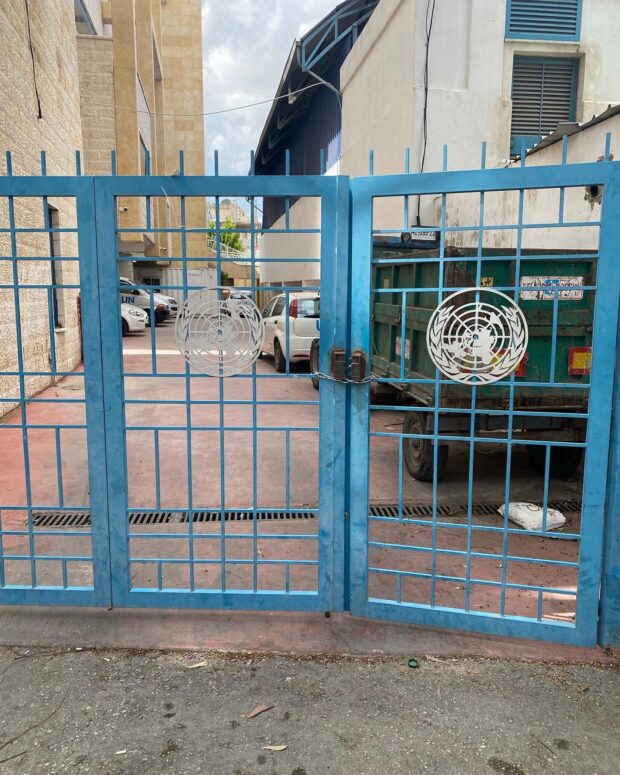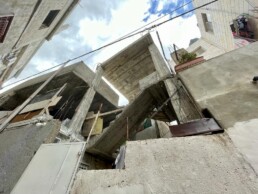Day 7: 'The Past is my ID': A Visit to Dheisheh Refugee Camp
The wheels of the Lilian, our trusted bus, spun on empty streets this morning. It was Saturday, Shabbat — the Jewish day of rest. Roads that are normally busy and chaotic lacked any sign of life. But as soon as we left the bus at Bethlehem’s Dheisheh refugee camp, we were welcomed by blasting music, children running across houses and the owner of a coffee cart who pressed Adjunct Professor Greg Khalil to buy a round for the group.

We were welcomed by our local guide, Hamza, 35, who was born and raised in the camp and works with children at the Ibdaa Cultural Center, a local organization focused on community-building. As we walked through the center, walls of awards and athletic trophies greeted us.
We sat down and Hamza —who joked that he's “a bit afraid of journalists” — told us his story.
While he spent his whole youth only 40 miles away from the sea, he swam for the first time at 22, and he remembered finally feeling free. Years later nothing has changed. When Hamza asked the camp’s children one day if they had ever seen the sea, only one child raised his hand; he said he had seen the sea on his television.
The Israeli army routinely comes into the camp in the middle of the night to make arrests, he said. They come by jeep, sometimes shooting tear gas or rubber bullets, while children in the camp fight back by throwing stones.
“The day is for us,” Hamza said. “The night is for them.”
Established in 1949, a year after the start of the Arab-Israeli War and the associated displacement of Palestinians, Dheisheh is located in the south of Bethlehem. The land was originally filled with tents, but as the years passed, the United Nations Relief and Work Agency (UNWRA) replaced them with concrete buildings. At the time, many of the camp’s inhabitants refused the switch, Hamza told us, because that would mean accepting that they were staying in a refugee camp. Many still hold keys to the homes they were forced to leave. But in the end, they had no choice.

The units were no bigger than three by three meters — Hamza called them “sardine boxes.” He grew up in one such box, which he shared with two parents and three siblings. As we walked through the camp and saw the residents’ cramped quarters, the reality of how small and confined that space is sank in.
Over time, Palestinian refugees started to build their own houses in the camp. As we walked through the narrow streets, walls of gray concrete towered over us. They are all built close to each other; after last month’s earthquake in Syria and Turkey, Hamza noted that if the same thing happened in this camp, it would be like “dominoes falling.” Some homes looked unfinished, with entire walls missing. Others appeared vacant, except for the laundry hanging to dry outside.

There are approximately 14,000 Palestinians in the camp. and more than half are children. We met several running around as chickens clucked in the background. “The camp is one family; it is full of life,” Hamza said.
The camp relies on humanitarian aid and sometimes loses basic services. Earlier this year, UNWRA, which supports health and education, was on strike, forcing schools and clinics to close for over two weeks.
Hamza lived in Paris for a few years and traveled to Sweden, Norway and Greece, but he has since returned back to his homeland. The fence around the camp came down in 1995, but Hamza emphasized the importance of staying in the camp, rather than moving away and starting a new life. Despite the many discomforts of living in the camp — including lack of reliable electricity or running water, to name a few — many of its inhabitants want to maintain their refugee status because it keeps them connected to their land and reminds the world that they have a right to return home.
“The past is my ID,” he said. “We are healing the past’s future.”
Driving back to Jerusalem, we reflected on the fact that the city felt like a whole other world, just 20 minutes away from the camp.
The rest of the day was filled with our own reporting, leaving Noelle Videon with her hands covered in Palestinian soil at the Tent of Nations, where she wheelbarrowed about olive plants across the property. For hours, she planted trees alongside other volunteers.
Others returned to Jerusalem, to explore and interview. Sarah Cutler spoke with a representative from the Greek Patriarchate about rising attacks on Palestinian Christians, while Laura Esposito spoke to interfaith couples. Hanna Nebiyu Vioque, Fiona André, Sherry Fernandes and Greg Dobak decided to visit Razzouk Ink, the oldest tattoo shop in the world, popular with pilgrims seeking a permanent reminder of their trip to the Holy Land.
As evening came and Shabbat ended, we headed to a bittersweet last dinner in Jerusalem. Apart from good food and cocktails, the night was filled with kind words and admiration. We toasted each other, realizing that, on this emotional trip, near strangers had turned into friends.
Druze Faith: A Philosophy Carried From Past to Present
Members of the Druze faith are scattered all over New York City; there is no house of worship where they can meet. Prayer is not central to the Druze religion, which makes a house of worship much less important than for other religions. In the Druze faith, not everyone identifies as religious. There are the initiated, who wear distinct garb and read the holy books, and the uninitiated who do not.
Still, all Druze are connected by their values and beliefs.
“It is a way of life,” said Wassim Malaeb, owner of Samad’s Gourmet, a small deli at Broadway and 111th Street in Manhattan. Malaeb, 54, will eagerly tell you that he is not religious, but he has become an informal teacher of the religion for many students at the nearby Columbia University who have questions about the Druze.
Malaeb is a Lebanese Druze; there are also Druze communities in Syria and Israel. There are fewer than one million members of the Druze faith, only 10 percent of whom are initiated in the faith’s religious practices.
Malaeb is always happy to provide over-the-counter wisdom about his faith. While he’s not formally religious, he says he feels more connected to his faith with every passing year. Still, he describes the Druze faith more as a philosophy than a religion — he says it “summarizes everything.”
A foundational principle of the Druze is the belief in reincarnation. The Druze’s holy book: Kitab al-Hikma, the Book of Wisdom, is only available to religious Druze. Thus, teaching holy scriptures or extensive religious services are not central to the community. You learn these principles through your upbringing, or between the vessels filled with nuts and spices in Samad’s Gourmet.
“Those who remember their past life are people who died too young and are still attached to life,” Malaeb said. He knows of one soul that he met twice in his lifetime, which is his proof that people are reincarnated. The moment of reincarnation is most visible within children: babies that cry are dreaming about their past lives; babies who are born dead are examples of souls that did not transfer.
Malaeb believes that God is within him. This is what allows him to move his body; it is the connection between body and soul. He also believes that this life affects the next — if you have been a good person, your next life will be much easier.
While Malaeb might not remember his own past life; his current life of food service and informal teaching can only mean that he was good in the previous one.


